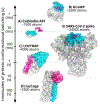The Next Frontier for Designing Switchable Proteins: Rational Enhancement of Kinetics
- PMID: 34324338
- PMCID: PMC8826494
- DOI: 10.1021/acs.jpcb.1c04082
The Next Frontier for Designing Switchable Proteins: Rational Enhancement of Kinetics
Abstract
Designing proteins that can switch between active (ON) and inactive (OFF) conformations in response to signals such as ligand binding and incident light has been a tantalizing endeavor in protein engineering for over a decade. While such designs have yielded novel biosensors, therapeutic agents, and smart biomaterials, the response times (times for switching ON and OFF) of many switches have been too slow to be of practical use. Among the defining properties of such switches, the kinetics of switching has been the most challenging to optimize. This is largely due to the difficulty of characterizing the structures of transient states, which are required for manipulating the height of the effective free energy barrier between the ON and OFF states. We share our perspective of the most promising new experimental and computational strategies over the past several years for tackling this next frontier for designing switchable proteins.
Conflict of interest statement
The authors declare the following competing financial interest(s): L.T.C. is an Open Science Fellow with Silicon Therapeutics.
Figures



References
-
- Adamson H; Jeuken LJC Engineering Protein Switches for Rapid Diagnostic Tests. ACS Sens. 2020, 5, 3001–3012. - PubMed
-
- Fersht AR; Matouschek A; Serrano L The Folding of an Enzyme. I. Theory of Protein Engineering Analysis of Stability and Pathway of Protein Folding. J. Mol. Biol 1992, 224, 771–782. - PubMed
Publication types
MeSH terms
Substances
Grants and funding
LinkOut - more resources
Full Text Sources
Miscellaneous

